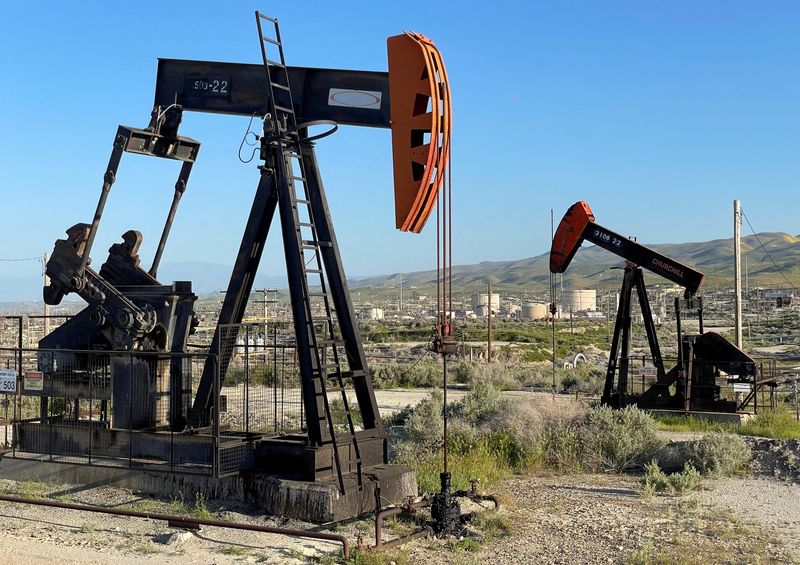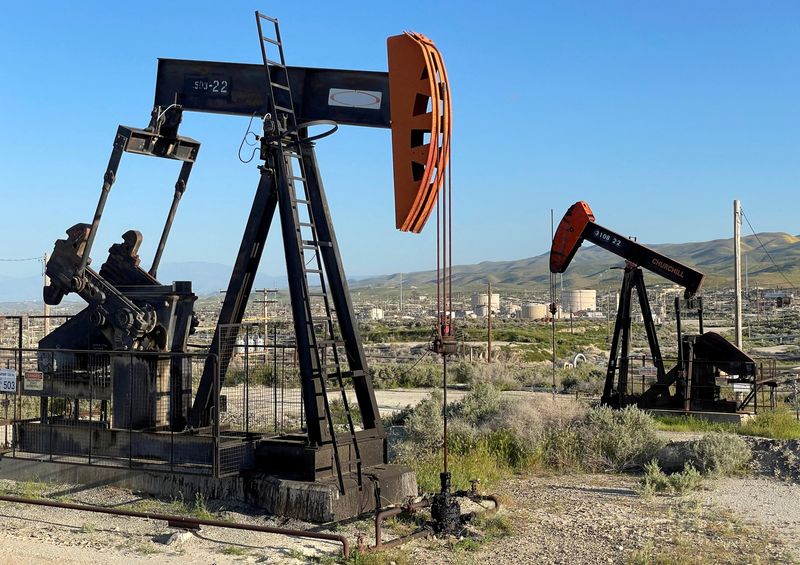Commodities
US finalizes higher fees for oil and gas companies on federal lands

By Nichola Groom
(Reuters) -President Joe Biden’s administration on Friday finalized a range of reforms designed to boost returns and address environmental harms from drilling on public lands, a move that will increase fees for oil and gas companies that operate there.
The new rules follow years of criticism from green and taxpayer groups that federal oil and gas development was not benefiting the public. Many of the changes by the Interior Department’s Bureau of Land Management (BLM) formalize provisions in Biden’s landmark climate change law, the 2022 Inflation Reduction Act (IRA).
Under the new policy, oil and gas companies will pay higher bonding rates to cover the cost of plugging abandoned oil and gas wells as well as increased lease rents, minimum auction bids and royalty rates for the fuels they extract. The rules also limit drilling in sensitive wildlife and cultural areas.
“These are the most significant reforms to the federal oil and gas leasing program in decades, and the will cut wasteful speculation, increase returns for the public, and protect taxpayers from being saddled with the costs of environmental cleanups,” Interior Secretary Deb Haaland said in a statement.
About 10% of the nation’s oil and gas comes from drilling on federally owned land. An oil and gas industry trade group warned that higher costs to extract fuels from federal lands could boost U.S. reliance on foreign supplies.
“Overly burdensome land management regulations will put this critical energy supply at risk,” American Petroleum Institute Vice President of Upstream Policy Holly Hopkins said in a statement.
Biden vowed during his 2020 election campaign to end federal oil and gas leasing as part of his agenda to combat climate change. But the IRA effectively guaranteed continued drilling rights auctions on federal lands for at least another decade as a concession to the powerful fossil fuel lobby.
Several environmental and taxpayer organizations praised the reforms, saying they would tamp down on speculation and hold oil and gas companies accountable for cleaning up old wells.
One group, Friends of the Earth, said the rules failed to address the climate impact of fuel extraction on public lands.
“While we support BLM’s steps to curb financial giveaways to Big Oil, this rule failes to confront the massive tide of climate emissions stemming from its leasing program,” Nicole Ghio, senior fossil fuels program manager at Friends of the Earth, said in a statement.
Drillers are required to pay upfront bonds to cover future cleanups if they fail, and a 2019 government analysis found bonding levels were inadequate.

Minimum lease bonds will soar to $150,000 under the new rules from $10,000 — a level unchanged since 1960.
Royalty rates will rise to 16.67% from 12.5%, and the minimum amount companies can bid at oil and gas auctions will increase to $10 an acre from $2. The rental rate for a 10-year lease will double to $3 an acre for the first two years, eventually rising to $15 per acre in the final years. The fees can be adjusted for inflation after 10 years.
Commodities
Oil settles down on US jobs data, steepest weekly loss in 3 months

By Nicole Jao
NEW YORK (Reuters) -Oil prices settled lower on Friday, and posted their steepest weekly loss in three months as investors weighed weak U.S. jobs data and possible timing of a Federal Reserve interest rate cut.
futures for July settled 71 cents lower, or 0.85%, to $82.96 a barrel. U.S. West Texas Intermediate crude for June fell 84 cents, or 1.06%, to $78.11 a barrel.
Investors were concerned that higher-for-longer borrowing costs would curb economic growth in the U.S., the world’s leading oil consumer, after the Federal Reserve decided this week to hold interest rates steady.
For the week, Brent declined more than 7%, while WTI fell 6.8%.
U.S. job growth slowed more than expected in April and the annual wage gain cooled, data showed on Friday, prompting traders to raise bets that the U.S. central bank will deliver its first interest rate cut this year in September.
“The economy is slowing a little bit,” said Tim Snyder, economist at Matador Economics. “But (the data) gives a path forward for the Fed to have at least one rate cut this year,” he said.
The Fed held rates steady this week and flagged high inflation readings that could delay rate cuts. Higher rates typically weigh on the economy and can reduce oil demand.
The market is repricing the expected timing of possible rate cuts after the release of softer-than-expected monthly jobs data, said Giovanni Staunovo, an analyst at UBS.
U.S. energy companies this week cut the number of oil and rigs operating for a second week in a row, to the lowest since January 2022, Baker Hughes said in its closely followed report on Friday.
remove ads
.
The oil and gas rig count, an early indicator of future output, fell by eight to 605 in the week to May 3, in the biggest weekly decline since September 2023. The number of oil rigs fell seven to 499 this week, in the biggest weekly drop since November 2023. [RIG/U]
Geopolitical risk premiums due to the Israel-Hamas war have faded as the two sides consider a temporary ceasefire and hold talks with international mediators.
Further ahead, the next meeting of OPEC+ oil producers – members of the Organization of the Petroleum Exporting Countries and allies including Russia – is set for June 1.
Three sources from the OPEC+ group said it could extend its voluntary oil output cuts beyond June if oil demand does not increase.
Money managers cut their net long futures and options positions in the week to April 30, the U.S. Commodity Futures Trading Commission (CFTC) said.
Commodities
Oil prices fall as hefty weekly losses loom on bets on tighter supplies suffer hit

Investing.com– Oil prices fell Friday, to remain on course for steep losses this week even as the dollar weakened following a weaker-than-expected U.S. jobs report, while data pointing to rising U.S. supplies reined in bets for tighter markets.
At 14:10 ET (18:10 GMT), fell 0.6% to $84.20 a barrel, while gained 0.6% to $79.44 a barrel. Oil prices are trading close to their weakest levels in seven weeks, and were set to lose between 5% and 6% this week.
Weaker dollar fails to turn negative tide as crude set for hefty weekly losses
The dollar fell as rate-cut hopes were boosted by data showing tight U.S. labor market is cooling after job gains and wages fell in April.
“Our forecast remains for three 25bp cuts this year starting in July, but have highlighted the path to cut in July has gotten narrower following the reinflation in 1Q24 data,” Morgan Stanley said in a Friday note.
As oil is priced in dollar, a weaker dollar tends to boost demand for non-dollar investors. Despite the dollar weakness was of little comfort to oil prices as most of the damage occurred earlier this week following an unexpected build in U.S. and data showing increased U.S. production.
This was coupled with easing fears of supply disruptions in the Middle East, as Israel and Hamas continued negotiations over a potential ceasefire.
Baker Hughes rig count dips below 500
Oilfield services firm Baker Hughes Co (NYSE:BKR) reported its weekly U.S. rig count, a leading indicator of future production, rose fell 499 from 506, pointing to weaker drilling activity even as the demand-heavy U.S. summer driving season approach.
remove ads
.
But the fall in rigs just as domestic output is rising suggest that drillers are squeezing more out of existing wells.
OPEC+ could extend production cuts
Still, crude found some relief on Friday from a softer , as the greenback retreated in anticipation of the nonfarm payrolls data.
Also helping the tone was a report from Reuters that the Organization of Petroleum Exporting Countries and allies, a group known as OPEC+, could potentially maintain their current run of 2.2 million barrels per day of production cuts beyond the end-June deadline, especially if demand does not pick up.
But cartel members are yet to begin formal talks over the matter. Still, extended production cuts by the cartel could herald tighter markets later in 2024.
Adnoc, the UAE’s national oil company, has increased its production capacity by 200,000 barrels per day to 4.85 million b/d, leaving the producer with a spare capacity above 1.7m b/d, after producing a little over 3.1m b/d in April.
“This could see the UAE push for a higher baseline when OPEC+ discusses its output policy for the second half of 2024,” ING added.
(Peter Nurse, Ambar Warrick contributed to this article.)
Commodities
Oil settles down on US jobs data, steepest weekly loss in 3 months

By Nicole Jao
NEW YORK (Reuters) -Oil prices settled lower on Friday, and posted their steepest weekly loss in three months as investors weighed weak U.S. jobs data and possible timing of a Federal Reserve interest rate cut.
futures for July settled 71 cents lower, or 0.85%, to $82.96 a barrel. U.S. West Texas Intermediate crude for June fell 84 cents, or 1.06%, to $78.11 a barrel.
Investors were concerned that higher-for-longer borrowing costs would curb economic growth in the U.S., the world’s leading oil consumer, after the Federal Reserve decided this week to hold interest rates steady.
For the week, Brent declined more than 7%, while WTI fell 6.8%.
U.S. job growth slowed more than expected in April and the annual wage gain cooled, data showed on Friday, prompting traders to raise bets that the U.S. central bank will deliver its first interest rate cut this year in September.
“The economy is slowing a little bit,” said Tim Snyder, economist at Matador Economics. “But (the data) gives a path forward for the Fed to have at least one rate cut this year,” he said.
The Fed held rates steady this week and flagged high inflation readings that could delay rate cuts. Higher rates typically weigh on the economy and can reduce oil demand.
The market is repricing the expected timing of possible rate cuts after the release of softer-than-expected monthly jobs data, said Giovanni Staunovo, an analyst at UBS.
U.S. energy companies this week cut the number of oil and rigs operating for a second week in a row, to the lowest since January 2022, Baker Hughes said in its closely followed report on Friday.
remove ads
.
The oil and gas rig count, an early indicator of future output, fell by eight to 605 in the week to May 3, in the biggest weekly decline since September 2023. The number of oil rigs fell seven to 499 this week, in the biggest weekly drop since November 2023. [RIG/U]
Geopolitical risk premiums due to the Israel-Hamas war have faded as the two sides consider a temporary ceasefire and hold talks with international mediators.
Further ahead, the next meeting of OPEC+ oil producers – members of the Organization of the Petroleum Exporting Countries and allies including Russia – is set for June 1.
Three sources from the OPEC+ group said it could extend its voluntary oil output cuts beyond June if oil demand does not increase.
Money managers cut their net long futures and options positions in the week to April 30, the U.S. Commodity Futures Trading Commission (CFTC) said.

 Forex2 years ago
Forex2 years agoForex Today: the dollar is gaining strength amid gloomy sentiment at the start of the Fed’s week

 Forex2 years ago
Forex2 years agoHow is the Australian dollar doing today?

 Forex1 year ago
Forex1 year agoUnbiased review of Pocket Option broker

 Forex2 years ago
Forex2 years agoDollar to pound sterling exchange rate today: Pound plummeted to its lowest since 1985

 Cryptocurrency2 years ago
Cryptocurrency2 years agoWhat happened in the crypto market – current events today

 World2 years ago
World2 years agoWhy are modern video games an art form?

 Stock Markets2 years ago
Stock Markets2 years agoMorgan Stanley: bear market rally to continue

 Economy2 years ago
Economy2 years agoCrude oil tankers double in price due to EU anti-Russian sanctions

































